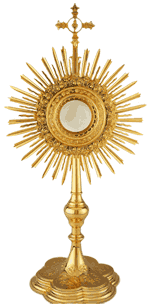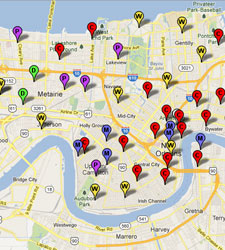The Basilica of St. Peter in the Vatican (photo left), is the second patriarchal church at Rome (after the Basilica of St. John Lateran), and under the main altar lies the precious mortal remains of St. Peter, the “rock” on which Christ built his Church. St. Peter was martyred during the persecutions of the Emperor Nero from 64-67 B.C. He was crucified upside down in Nero’s circus (arena) for the enjoyment of the crowds and to cast blame away from Nero after the Great Fire of Rome in July, 64 A.D. He was originally buried originally in a simple grave on the Vatican Hill.
The Basilica of St. Paul Outside the walls (photo right) lies over the remains of St. Paul, who was martyred during the same persecutions. Since Paul was a Roman citizen (having been born in Tarsus), he could not be killed for sport in the arena. He was martyred at the normal place for Roman executions on the Ostian Way. He was decapitated by a sword, and his body was buried where his church now stands.
From the beginning – before the churches were built – Christians showed extraordinary devotion to the tombs of the two “princes” of the Apostles. In a letter written in 210 A.D. by Caius, an eloquent priest of Rome, explains to Proclus the Montanist (who denied the authority of the Apostles and their Successor Bishops): “I can show you the trophies of the apostles. For, whether you go to the Vatican hill, or to the Ostian road, you will meet with the monuments of them who by their preaching and miracles founded this Church.”
Even during times of persecution, Christians adorned the tombs of the martyrs and the small oratories (places of prayer) which they erected over them, frequently prayed there. After Constantine the Great made Christianity legal in 313 A.D., he built the Lateran Basilica, as well as seven more churches in Rome and many more in other parts of the Roman Empire. The first two of these were the churches of St. Peter on the Vatican hill and that of St. Paul on the Ostian Way.
As St. Augustine so eloquently stated, “We erect churches or appoint priesthoods, sacred rites, and sacrifices to the martyrs; because the God of the martyrs is our God. Who, among the faithful, ever heard a priest standing at the altar which is erected over the body of a martyr to the honor and worship of God say, in praying, We offer up sacrifices to thee, O Peter, or Paul, or Cyprian; when at their memories it is offered to God, who made them both men and martyrs, and has associated them to his angels in heavenly honors… We build not churches to martyrs as to gods, but memories as to men departed this life, whose souls live with God. Nor do we erect altars to sacrifice on them to the martyrs, but to the God of the martyrs and our God.”




